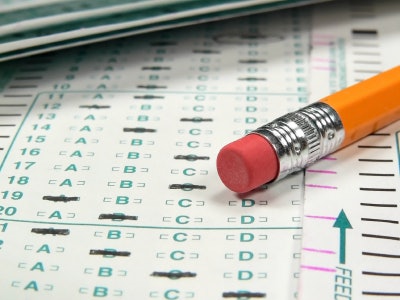 More than 700,000 high school dropouts take the General Educational Development exam each year.
More than 700,000 high school dropouts take the General Educational Development exam each year.
The new exam will have four parts and cost much more — $120, a fee that includes the book. It will also be computerized. And while few people outside the agency that administers the test have seen the exam, experts and adult education administrators say the earliest indications are that it will be more rigorous.
Some welcome the rigor, but others worry that the changes will discourage people from taking the exam. Historically, the number of test takers has declined in the year or two after the exam was adjusted; the pass rate has also dropped. Experts predict the trend won’t be any different this time. They worry that it would discourage many from pursuing some form of higher education and could impact enrollment at some higher education institutions, like community colleges and technical schools. They say this trend could be more pronounced among many minority groups. Approximately 50 percent of the test takers are people of color. Blacks and Hispanics make up about four-fifths of these exam candidates.
More than 700,000 high school dropouts take the exam each year. More than half of these examinees report that they take the exam because they want to pursue some higher education. But many critics have long charged that the GED lacks the rigor of the traditional high school diploma.
The changes to the exam are designed to heighten the standard, align it with the common core curriculum at traditional high schools and to better prepare students for college. More to the point, educators want the exam to reflect the learning and outcomes in regular school systems, says Dr. Jacqueline Korengel, director of strategic initiatives and GED administrator for Kentucky Adult Education, part of the Council on Postsecondary Education. Increasingly, she says, more jobs are requiring some postsecondary education. Organizers of the GED recognize this and have adapted the test to help prepare them for college.
But concern that these changes might have a deleterious effect on people of color — at least initially — lingers.
“I think it would mean that fewer people will be able to get that credential,” says Emily Hanford, a producer at American Radio Works, whose hour-long documentary on the GED is airing on public radio outlets. “The GED is disproportionately something that people from low-income and minority communities get. Low-income people and people of color are being disproportionately served by this test, and they are being disproportionately harmed by this test.”
Christy Jaeger, director of continuing education at St. Louis County Community College, a 75,000-student district that provides GED services, says there are other uncertainties.
“At our community college, the second-largest group of students who come are GED recipients,” says Jaeger, adding that she anticipates a decrease in enrollment in the short term, either because fewer students might take the exam or pass it
“In the long term, we’re concerned with the new high school equivalency testing being more aligned with competency standards. We are concerned about what the scores would look like. Currently, 70 percent of our students who take the test pass.”
She says she and her colleagues worry the increase in rigor might impact the pass rate.
She is also concerned about the affordability of the test. Most people who take the test come from lower socio-economic backgrounds. Jaeger says the cost increase of the test could be a barrier for some, particularly minorities.
“Individuals of color, particularly with lower economic levels, have lower incomes,” she says.
Adds Gloria Mobley, GED exam coordinator at Cuyahoga County Community College in Cleveland, “Most of our clientele are individuals who are unemployed or make minimum wage; $120 is a lot.”
But Mobley says there’s an upside to the setup of the new exam. Unlike the old exam, she says, examinees can take one section at a time. This way, they could pay for it in installments of $30 as opposed to having to cough up the whole amount at one time.
Paula Kertes, interim director of ABLE/GED programs at Cuyahoga County Community College says the state of Ohio is exploring the possibility of providing some funding that would hold costs of tests at $40 if the test takers go through certain career centers.
Both Kertes and Mobley say they don’t see enrollment dropping at their college as a result of the new GED test because, like many community colleges, they are an open-access school. Students may take classes without a high school diploma, albeit without financial aid. And in order to complete their degrees at the college, they must meet the high school diploma requirement.
But Jaeger says she also worries about being able to adequately prepare students for the exam.
“We haven’t seen a lot of the new test, so we don’t know what we have to do to help people be better prepared,” she says. “We’re nervous, particularly about the math portion. We hear there’s a lot of algebra and that it involves more critical thinking. We don’t have enough new information to get ahead of the curve.”





















